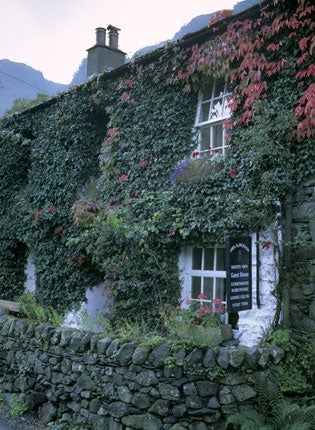Ivy 'protects buildings' by regulating temperature

Your support helps us to tell the story
From reproductive rights to climate change to Big Tech, The Independent is on the ground when the story is developing. Whether it's investigating the financials of Elon Musk's pro-Trump PAC or producing our latest documentary, 'The A Word', which shines a light on the American women fighting for reproductive rights, we know how important it is to parse out the facts from the messaging.
At such a critical moment in US history, we need reporters on the ground. Your donation allows us to keep sending journalists to speak to both sides of the story.
The Independent is trusted by Americans across the entire political spectrum. And unlike many other quality news outlets, we choose not to lock Americans out of our reporting and analysis with paywalls. We believe quality journalism should be available to everyone, paid for by those who can afford it.
Your support makes all the difference."False friendship, like the ivy," the explorer Sir Richard Burton once said, "decays and ruins the walls it embraces."
But the man who translated One Thousand and One Nights into English may have been doing the much-maligned creeping plant a disservice. Research from Oxford University suggests that, far from decaying walls – as has long been thought – it actually protects them.
A team of academics from the university, led by Professor Heather Viles, found that ivy canopies shielded walls against changing temperatures – the most serious issue for British architecture, according to Viles. It also protects against weathering.
"It seems to be a very long-term view that ivy is damaging and it is mainly from people's observations, rather than scientific research," she said, adding: "If you have a wall with lots of holes, nooks and crannies in it, ivy will take hold, so people put two and two together.
"In many cases where walls were already damaged, ivy would also be used to cover them up. When, later, they were uncovered, people would think the ivy was to blame."
The study showed that ivy kept the surface temperature of the walls relatively constant. The plant, it showed, also absorbed some of the harmful pollutants in the atmosphere.
Earlier this year, the American state of Oregon even banned the sale of ivy. But Professor Viles said she hoped that may change with the release of her team's research.
"Ivy has been accused of destroying everything in its path and threatening some of our best-loved heritage sites. Yet these findings suggest that there are many benefits to having ivy growing on the wall. It not only provides colourful foliage but also provides walls with weather-proofing and protection from the effects of pollution.
"This research does not provide a hard-and-fast rule – there will indeed be conditions where removing ivy is the best thing to do – but policy on this type of thing has often been made based on received wisdom. We are providing scientific research."
The study was commissioned by English Heritage, which wanted to discover what effect ivy was likely to have on important heritage sites. Professor Viles and her team studied sites in varying climates, including garden walls at Trinity, Pembroke and Worcester Colleges, as well as the old city wall in Oxford. They also examined walls at the Dover Drop Redoubt fort, and a selection in North Yorkshire, Bristol and Leicester.
Alan Cathersides, a senior landscape manager at English Heritage, said: "English Heritage are always keen to avoid unnecessary work to monuments and hope this research will lead to a more balanced approach to ivy. Removal should not be automatic as so often in the past, but a carefully considered element of long-term management."
The research team monitored wall moisture levels and measured the temperature and relative humidity beneath the ivy canopy, compared to bare walls.
The researchers built a test wall, planting ivy at the base, at Wytham Woods in Oxfordshire. The cube-shaped wall contains different flaws so researchers could measure and compare the different deterioration rates.
Professor Viles will be presenting the team's findings to a Geological Society of London conference next week. She said she hopes the discussions will result in a set of guidelines on how to deal with ivy being drawn up.
Join our commenting forum
Join thought-provoking conversations, follow other Independent readers and see their replies
Comments